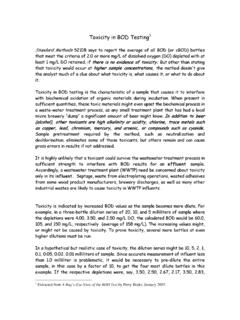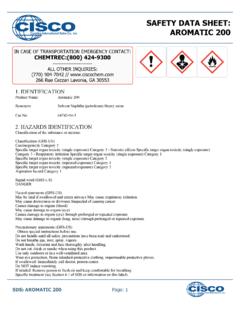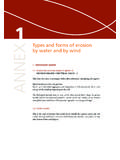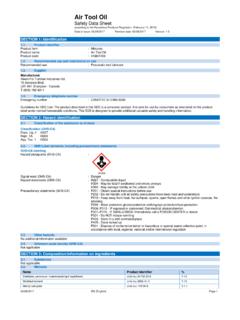Transcription of Health Protection Agency - WHO
1 Health Protection Agency Compendium of Chemical Hazards: Diesel. Prepared by: Robert P Chilcott Chemical Hazards and Poisons Division (HQ), Chilton, Didcot, Oxfordshire, OX11 0RQ, United Kingdom. Disclaimer This guidance has been provided by the Chemical Hazards and Poisons Division of the UK Health Protection Agency (HPA). It is general guidance based on current knowledge and understanding. The HPA does not warrant that the information and guidance is complete and correct for use in all circumstances. The HPA shall not be liable for any damages that might be incurred as a result of the use of the guidance or information. HPA Compendium of Chemical Hazards Diesel Key Points Fire Flammable Vapour / air mixtures may be explosive Use foam and liquid-tight protective clothing with breathing apparatus Health Irritating to eyes, respiratory ststem and skin Severe lung injury may occur following aspiration of liquid Possible carcinogen Environment Dangerous for the environment Inform Environment Agency of substantial incidents Prepared by R P Chilcott, CHAPD HQ.
2 2006. Version 1. DIESEL CONTENTS. Contents GENERAL INFORMATION. Background Production and Uses Frequently Asked Questions INCIDENT MANAGEMENT. Hazard Identification Standard (UK) Dangerous Goods Emergency Action Codes Chemical Hazard Information and Packaging for Supply Classification(). Physicochemical Properties Threshold toxicity Values Published Emergency Response Guidelines Emergency Response Planning Guideline (ERPG) Values Acute Exposure Guideline Levels (AEGLs). Exposure Standards, Guidelines or Regulations Occupational standards Public Health guidelines Health Effects Major route of exposure Immediate Signs or Symptoms of Acute Exposure Decontamination and First Aid Dermal exposure Ocular exposure Inhalation Ingestion TOXICOLOGICAL OVERVIEW. Toxicological Overview Summary of Health effects Kinetics and metabolism Sources and route of human exposure Health Effects of Acute / Single Exposure Human Data General toxicity Inhalation Ingestion Dermal / ocular exposure Neurotoxicity Nephrotoxicity Delayed effects following an acute exposure Animal and In-Vitro Data General toxicity Delayed effects following an acute exposure Health Effects of Chronic / Repeated Exposure Human Data General toxicity Inhalation Ingestion Dermal / ocular exposure Genotoxicity Carcinogenicity Reproductive and developmental toxicity Animal and In-Vitro Data General toxicity Inhalation Ingestion Dermal / ocular exposure Genotoxicity Carcinogenicity Reproductive and developmental toxicity References Annex I: Categories of diesel additives.
3 Annex II: UK Classification of fuel oils. Annex III: UK Physicochemical standards for diesel Diesel General information Key Points Fire Flammable Vapour / air mixtures may be explosive Use foam and liquid-tight protective clothing with breathing apparatus Health Irritating to eyes, respiratory system and skin Chemical pneumonitis may arise following aspiration of vomitus (secondary to ingestion) or inhalation of aerosol (or aspiration of liquid) during manual siphoning Prolonged skin exposure may cause skin irritation Possible carcinogen Diesel is considered not to be a human reproductive or developmental toxicant Environment Dangerous for the environment Inform Environment Agency of substantial incidents Prepared by R P Chilcott, CHAPD HQ. 2006. Version 1. DIESEL GENERAL INFORMATION. Background Diesel is a complex mixture of chemicals mainly obtained from the distillation of crude oil. The product is thought to be named after Dr Rudolf Diesel, a German engineer who, in 1892, patented an oil-burning internal combustion engine.
4 Modern diesel engines also incorporate features of a design (patented between 1886 and 1890) by the Yorkshireman Herbert Akroyd Stuart . The use of diesel to clean skin and hair In the UK, diesel' or DERV refers to a fuel should be strongly discouraged as this for running cars, vans and lorries. However, practice has been known to cause serious the term diesel' is also used to describe a kidney damage. range of different fuels such as artic' and marine' diesel or as an alternative name for kerosene, all of which differ considerably in composition and physical properties. In 2004, approximately 700 litres (150. gallons) of diesel was sold every second in the UK. Most diesel is ultra-low in sulphur content in order to limit the emission of sulphur-containing pollutants from engine exhaust fumes. Diesel is not considered to be particularly toxic and accidental poisoning is very rare. However, if diesel is swallowed, medical advice should be obtained immediately as there is a small risk of short-term lung damage if vomiting occurs or if droplets of diesel are inhaled.
5 Long-term skin exposure to diesel may result in eczema (dermatitis). and should be avoided. DIESEL GENERAL INFORMATION. Production and Uses Key Points Production and uses Diesel is produced by mixing fractions of crude oil distillates (petrochemicals) with various, brand-specific additives. Approximately 22 thousand million litres (5 thousand million gallons) of diesel were sold in the UK in 2004, equating to 700 litres (150 gallons) per second. Diesel is produced by blending straight-run middle distillates (minimum 40%) with varying proportions of straight-run gas oil, light vacuum distillates, light thermally-cracked distillates and light catalytically-cracked distillates. The quantity of diesel released by HM Revenue and Customs for consumption in the UK in 2004 was approximately 22 thousand million litres (5 thousand million gallons), the majority ( ) of which was ultra-low sulphur diesel for automotive engines. Diesel is also used as a cleaning solvent for tanks, engines and refinery equipment.
6 DIESEL GENERAL INFORMATION. Frequently Asked Questions What is diesel? Diesel is a complex mixture of hydrocarbons produced by mixing fractions obtained from the distillation of crude oil with brand-specific additives to improve performance. It is a liquid under normal conditions with a characteristic odour. What is diesel used for? In the UK, diesel is mainly used as a fuel for road vehicles, although other forms of transport (such as ships and trains) and electricity generators also use certain types of diesel. How does diesel get into the environment? Diesel is found in the environment as a result of accidental release from an industrial site or transport vehicle. There are no natural sources of diesel. If there is diesel in the environment will I have any adverse Health effects? Like most chemicals, the amount of diesel you are exposed to must be above a certain level to cause adverse Health effects. A short, one-off exposure to diesel will not normally cause any long-term Health effects.
7 Occasional skin exposure may lead to dermatitis (eczema). Breathing large quantities of diesel vapour or drinking diesel-based fluids may cause non- specific signs and symptoms of poisoning such as dizziness, headache and vomiting. A. severe form of lung damage called pneumonitis may occur if liquid diesel is inhaled directly onto the lungs, for example, whilst manually siphoning a tank or from inhaling vomit after swallowing diesel. This is why it is important not to make someone sick if they have swallowed diesel. Can diesel cause cancer? There is limited evidence from animal studies that prolonged exposure may increase the risk of developing skin cancer. There is not thought to be any risk of cancer from short-term, occasional exposure. Can diesel affect or damage the unborn child? There is no evidence to suggest that exposure of a mother to diesel may harm the unborn child. However, as with all chemicals, it is obviously best to avoid unnecessary contact if possible.
8 Diesel Incident management Key Points Fire Flammable Vapours may be violently reactive with air Use foam and liquid-tight protective clothing with breathing apparatus Health toxicity occurs following ingestion, inhalation & skin absorption Possible carcinogen Irritating to eyes and skin Aspiration may cause serious lung injury Environment Avoid release into the environment Inform Environment Agency of substantial incidents Prepared by R P Chilcott, CHAPD HQ. 2006. Version 1. DIESEL INCIDENT MANAGEMENT. (a). Hazard Identification Standard (UK) Dangerous Goods Emergency Action Codes UN 1202 Diesel Fuel or Gas Oil or Heating Oil, Light Use normal foam. Wear normal fire kit in combination with breathing apparatus*. Spillages and decontamination run-off EAC 3Y. should be prevented from entering drains and watercourses. Substance can be violently or explosively reactive. APP - Class 3 Flammable liquid Hazards Sub - risks Flammable liquid (flash point between 23 C and 61 C.)
9 Inclusive) or flammable liquid or solid in the molten state with HIN 30. a flash point above 61 C, heated to a temperature equal to or above its flash point, or self-heating liquid UN United Nations number; EAC Emergency Action Code; APP Additional Personal Protection ; HIN - Hazard Identification Number * Normal fire fighting clothing fire kit (BS EN 469), gloves (BS EN 659) and boots (HO specification A29 and A30) in combination with self-contained open circuit positive pressure compressed air breathing apparatus (BS EN 137). a Dangerous goods emergency action code list, HM Fire Service Inspectorate, Publications Section, The Stationery Office, 2004. DIESEL INCIDENT MANAGEMENT. Chemical Hazard Information and Packaging for Supply Classification( a ). Classification Carc cat 3 Category 3 carcinogen Risk phrases R40 Limited evidence of a carcinogenic effect S(2) Keep out of the reach of children Safety phrases S36/37 Wear suitable protective clothes and gloves a Approved supply list (seventh edition): information approved for the classification and labelling of substances and preparations dangerous for supply.
10 Chemical (Hazard Information and Packaging for Supply) Regulations 2002. The Stationery Office, 2002. DIESEL INCIDENT MANAGEMENT. (a,b). Physicochemical Properties Volatility Low volatility; vapour pressure < 1 mm Hg Specific gravity at 15 C (water = 1). Flammability Flammable. Lower explosive limit Upper explosive limit Water solubility mg 100 mL-1. Reactivity Vapours may be violently reactive with air Reaction or degradation May liberate irritating or toxic fumes during combustion products Odour Characteristic odour a International Chemical Safety Card (ICSC) entry for diesel fuel no 2. ISCS 1561. International Occupational Safety and Health Information Centre (CIS), 2004. b CIRUS entry for diesel, 2005. DIESEL INCIDENT MANAGEMENT. (a). Threshold toxicity Values THRESHOLD LEVELS. EXPOSURE BY INHALATION. SYMPTOMS. ppm mg m-3. - - Data not available a Hydrocarbons (MEDITEXT Medical Management). In: Klasco RK (Ed): TOMES System. Thomson Micromedex, Greenwood Village, Colorado (Edition expires [03, 2006]).

















